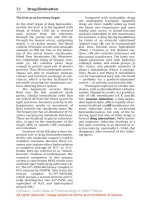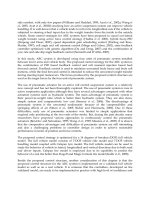Cephalometry A Color Atlas and Manual - part 4 pptx
Bạn đang xem bản rút gọn của tài liệu. Xem và tải ngay bản đầy đủ của tài liệu tại đây (2.46 MB, 37 trang )
CHAPTER 3
101
3.3 Definition of the Nasion and Sella 3-D Cephalometric Landmarks
Fig. 3.15. Nasion.Profile view right (3-D CT, patient K.C.) Fig. 3.16. Nasion.Profile view left (3-D CT, patient K.C.)
Fig. 3.14. Nasion.Frontal view (3-D CT, patient K.C.)
CHAPTER 3
102
3-D Cephalometric Reference System
Fig. 3.17. Nasion.Virtual lateral and frontal
cephalograms linked to the 3-D hard tissue
surface representation (patient K.C.)
CHAPTER 3
103
3.3 Definition of the Nasion and Sella 3-D Cephalometric Landmarks
Sella: S
Definition of the Sella Landmark
Sella is the centre of the hypophyseal fossa
(sella turcica).
Fig. 3.20. Sella.Endocranial skull base view (cadaver skull)
Fig. 3.18. Sella.Paramedian view right (cadaver skull) Fig. 3.19. Sella.Paramedian view right (3-D CT,cadaver skull)
Fig. 3.21. Sella.Endocranial skull base view (3-D CT, cadaver skull)
CHAPTER 3
104
3-D Cephalometric Reference System
Virtual Definition of the Sella Landmark
Step 1: Define Sella on the virtual lateral cephalo-
gram (Figs. 3.22, 3.23).
Step 2: Verify the position of the Sella landmark
on the left and right paramedian views of
the 3-D hard tissue surface representation
(Figs. 3.24, 3.25).
Step 3: Verify the midline position of the Sella land-
mark on the endocranial skull base view
(Fig. 3.26).
Fig. 3.22. Sella.Virtual lateral cephalogram (patient K.C.) Fig. 3.23. Sella. Virtual lateral cephalogram linked to the 3-D hard tissue
representation
CHAPTER 3
105
3.3 Definition of the Nasion and Sella 3-D Cephalometric Landmarks
Fig. 3.24. Sella.Paramedian view right (3-D CT,patient K.C.) Fig. 3.25. Nasion.Paramedian view left (3-D CT, patient K.C.)
Fig. 3.26. Sella.Endocranial skull base view (3-D CT, patient K.C.)
CHAPTER 3
106
3-D Cephalometric Reference System
3.4
Set-up of the Anterior Cranial Base (S-N) Plane
Once virtual definition of the Nasion and Sella 3-D
cephalometric landmarks is accomplished, the anteri-
or cranial base (S-N) plane is automatically computed.
Virtual Definition
of the Anterior Cranial Base (S-N) Plane
The anterior cranial base (S-N) plane is a plane that
passes the Nasion and Sella landmarks and is perpen-
dicular to the virtual lateral cephalogram (Fig. 3.27).
Fig. 3.27. Anterior cranial base (S-N) plane.Virtual lateral cephalogram linked to the 3-D hard tissue surface representation (3-D CT, patient K.C.)
CHAPTER 3
107
3.5 Set-up of the 3-D Cephalometric Reference System
3.5
Set-up of the 3-D Cephalometric Reference System
With the geometric information that is now available,
the 3-D virtual scene approach allows the automatic
generation of a 3-D cephalometric reference system as
an anatomic Cartesian coordinate system.
Virtual Definition of the 3-D Cephalometric
Reference System
The horizontal (x) 3-D cephalometric reference plane
is automatically computed as a plane 6 degrees below
the anterior cranial base (S-N) plane, with the origin in
Sella perpendicular to the virtual lateral cephalogram
(Fig. 3.28). The vertical (y) 3-D cephalometric refer-
ence plane is computed as a plane with the origin
in Sella and perpendicular to the horizontal (x) 3-D
cephalometric reference plane. The median (z) 3-D
cephalometric reference plane is computed as a plane
with the origin in Sella and perpendicular to both the
horizontal (x) and the vertical (y) 3-D cephalometric
reference plane (Fig. 3.29).
CHAPTER 3
108
3-D Cephalometric Reference System
3-D Cephalometric Reference System
Fig. 3.28. Horizontal (x) 3-D cephalometric reference plane.Virtual lateral cephalogram linked to the 3-D hard tissue surface representation (3-D CT,patient K.C.)
CHAPTER 3
109
3.5 Set-up of the 3-D Cephalometric Reference System
Fig. 3.29. 3-D cephalometric reference system.Virtual lateral cephalogram linked to the 3-D hard tissue surface representation (3-D CT, patient K.C.)
CHAPTER 3
110
3-D Cephalometric Reference System
Fig. 3.30. 3-D cephalometric reference system.Virtual lateral cephalogram linked to the 3-D soft tissue surface representation (3-D CT,patient K.C.)
CHAPTER 3
111
3.5 Set-up of the 3-D Cephalometric Reference System
Fig. 3.31 a, b. 3-D cephalometric reference system superimposed on the hard tissue surface representations (3-D CT, patient K.C.)
Fig. 3.32 a, b. 3-D cephalometric reference system superimposed on the hard and transparent soft tissue surface representations (3-D CT, patient K.C.)
ab
ab
CHAPTER 3
112
3-D Cephalometric Reference System
Fig. 3.33 a, b. 3-D cephalometric reference system superimposed on the soft tissue surface representations (3-D CT, patient K.C.)
ab
3-D Cephalometric
Hard Tissue Landmarks
Gwen R. J. Swennen
4.1 Definition of 3-D Cephalometric
Hard Tissue Landmarks
116
4.2 Set-up of 3-D Cephalometric
Hard Tissue Landmarks
174
4.3 Additional 3-D Cephalometric
Hard Tissue Landmarks
181
CHAPTER 4
CHAPTER 4
113
CHAPTER 4
115
Cephalometric radiography, introduced by Broadbent
and Hofrath in 1931, allows orthodontists, maxillo-
facial, craniofacial and plastic surgeons to diagnose
the patient’s craniofacial morphology and growth and
enables them to plan, monitor and evaluate the appro-
priate treatment. The most important shortcoming
of cephalometric radiography is its two-dimensional
character. Lateral cephalometric radiographs are most
commonly used and allow 2-D evaluation of cranio-
facial morphology and growth but ignore the medio-
lateral axis. Frontal cephalometric radiographs are
useful for facial asymmetry assessment but neglect
the postero-anterior dimension. Multi-planar cephalo-
metric radiography was developed by Grayson and
co-workers. By tracing cephalometric landmarks lo-
calized on the midsagittal plane (Sella, Nasion, An-
terior Nasal Spine, incisal tip of maxillary central inci-
sor, incisal tip of mandibular central incisor, Menton
and Pogonion) on both lateral and postero-anterior
cephalometric radiographs, 3-D cephalograms could
be generated after combining and integrating the data
of both 2-D projecting cephalograms. The major
shortcoming of this method is that the 3-D cephalo-
gram does not present a truly 3-D depiction; they are
generated from 2-D cephalometric radiographs, which
involves an inherent analysis bias.
Recent innovations in computer software technolo-
gy enabled the development of a new virtual voxel-
based 3-D cephalometric method by our research
group. This approach of 3-D cephalometry is based on
a single dataset in which virtual lateral and frontal
cephalograms are linked to the 3-D hard and soft tis-
sue surface representations. It is therefore less sensitive
to analysis bias than multi-planar cephalometric ra-
diography. Moreover, it offers real three-dimensional
landmark definition and cephalometric analysis.
Precise definition of cephalometric landmarks is es-
sential for the accuracy and reliability of the cephalo-
metric analysis. In this atlas we decided to define land-
marks that are situated on the bone (also referred as
“osseous”, “bony”) as “3-D cephalometric hard tissue
landmarks”, whereas landmarks situated on the skin
are termed “3-D cephalometric soft tissue landmarks”.
Abbreviations (symbols) for hard tissue landmarks
are in capitals as in conventional cephalometry,where-
as soft tissue landmarks are styled in lower-case letters
as in anthropometry and conventional soft tissue
cephalometric analysis.
This chapter deals with the definition and identifi-
cation of 3-D cephalometric hard tissue landmarks.
Accurate identification of landmarks requires anatom-
ic knowledge and experience in landmark definition.
Compared to conventional cephalometric radiogra-
phy, some landmarks (e.g. Anterior Nasal Spine) are
easier,others (e.g. Sella) more difficult to define in 3-D
cephalometry. Moreover, sometimes the definition of
conventional 2-D cephalometric landmarks has to be
modified because of the third dimension, or new 3-D
cephalometric landmarks (e.g. Posterior Maxillary
Point) have to be defined for computing 3-D cephalo-
metric planes. This chapter offers “step-by-step” guide-
lines for precise definition of 3-D cephalometric hard
tissue landmarks. A total of 18 landmarks in regard to
the facial skeletal units (forehead, nasal, periorbital,
midface and mandible) are described in detail. Two
other 3-D cephalometric hard tissue landmarks (Na-
sion and Sella) have already been described in Chap. 3.
Some more facial skeletal and skull cephalometric
landmarks are merely listed at the end of this chapter
because they have not yet been validated.
CHAPTER 4
116
3-D Cephalometric Hard Tissue Landmarks
4.1
Definition of 3-D Cephalometric Hard Tissue Landmarks
Porion: Po
r
– Po
l
Definition of the Porion Landmarks
Porion (Po) is the most superior point of each external
acoustic meatus.
Fig. 4.1. Porion
r
.Profile view right (cadaver skull) Fig. 4.2. Porion
r
.Profile view right (3-D CT, cadaver skull)
CHAPTER 4
117
4.1 Definition of 3-D Cephalometric Hard Tissue Landmarks
Virtual Definition of the Porion Landmarks
Step 1: Define Porion
r
and Porion
l
on the right
(Fig. 4.3) and left (Fig. 4.4) profile views of the
3-D hard tissue surface representations.
Step 2: Verify the transversal position of Porion
r
and
Porion
l
on the linked virtual frontal cephalo-
gram (Fig. 4.5).
Fig. 4.3. Porion
r
.Profile view right (3-D CT, patient K.C.)
Fig. 4.5. Porion.Virtual frontal cephalogram linked to the 3-D hard tissue sur-
face representation (3-D CT, patient K.C.) allows verification of the transversal
position of the Porion landmarks
Fig. 4.4. Porion
l
.Profile view left (3-D CT, patient K.C.)
CHAPTER 4
118
3-D Cephalometric Hard Tissue Landmarks
Orbitale: Or
r
– Or
l
Definition of the Orbitale Landmarks
Orbitale (Or) is the most inferior point of each infra-
orbital rim.
Fig. 4.6. Orbita
r
and Orbita
l
.Frontal view (cadaver skull) Fig. 4.7. Orbita
r
and Orbita
l
.Frontal view (3-D CT, cadaver skull)
CHAPTER 4
119
4.1 Definition of 3-D Cephalometric Hard Tissue Landmarks
Virtual Definition of the Orbitale Landmarks
Step 1: Define Orbita
r
and Orbita
l
on the frontal view
of the 3-D hard tissue surface representation
(Fig. 4.8).
Step 2: Verify the position of Orbita
r
and Orbita
l
on the linked virtual frontal cephalogram
(Fig. 4.9).
Fig. 4.8. Orbita
r
and Orbita
l
.Frontal view (3-D CT, patient K.C.) Fig. 4.9. Orbita
r
and Orbita
l
.Virtual frontal cephalogram linked to the 3-D hard
tissue surface representation (3-D CT, patient K.C.) allows verification of the
position of the Orbita
r
and Orbita
l
landmarks
CHAPTER 4
120
3-D Cephalometric Hard Tissue Landmarks
Anterior Nasal Spine: ANS
Definition of the Anterior Nasal Spine Landmark
Anterior Nasal Spine is the most anterior midpoint of
the anterior nasal spine of the maxilla.
Fig. 4.12. Anterior nasal spine.Profile view right (cadaver skull) Fig. 4.13. Anterior nasal spine.Profile view right (3-D CT, cadaver skull)
Fig. 4.10. Anterior nasal spine.Frontal view (cadaver skull) Fig. 4.11. Anterior nasal spine.Frontal view (3-D CT, cadaver skull)
CHAPTER 4
121
4.1 Definition of 3-D Cephalometric Hard Tissue Landmarks
Virtual Definition of the Anterior Nasal Spine Landmark
Step 1: Define Anterior Nasal Spine on the virtual
lateral cephalogram (Figs. 4.14, 4.15).
Step 2: Verify and correct the median position
of Anterior Nasal Spine on the frontal view of
the 3-D hard tissue surface representation
(Fig. 4.16).
Step 3: The position of Anterior Nasal Spine is veri-
fied on the left and right 3-D profile views of
the 3-D hard tissue surface representations
(Figs. 4.17, 4.18.). Additionally Anterior Nasal
Spine can be verified on the virtual frontal
cephalogram linked to the 3-D hard tissue
surface representation (Fig. 4.19).
Fig. 4.14. Anterior Nasal Spine.Virtual lateral cephalogram (patient K.C.) Fig. 4.15. Anterior Nasal Spine. Virtual lateral cephalogram linked to the 3-D
hard tissue surface representation (patient K.C.)
CHAPTER 4
122
3-D Cephalometric Hard Tissue Landmarks
Fig. 4.16. Anterior Nasal Spine.Frontal view (3-D CT, patient K.C.)
Fig. 4.17. Anterior Nasal Spine.Profile view right (3-D CT, patient K.C.) Fig. 4.18. Anterior Nasal Spine.Profile view left (3-D CT, patient K.C.)
CHAPTER 4
123
4.1 Definition of 3-D Cephalometric Hard Tissue Landmarks
Fig. 4.19. Anterior Nasal Spine.Virtual frontal
cephalogram linked to the 3-D hard tissue surface
representation (3-D CT, patient K.C.)
CHAPTER 4
124
3-D Cephalometric Hard Tissue Landmarks
Posterior Nasal Spine: PNS
Definition of the Posterior Nasal Spine Landmark
Posterior Nasal Spine is the most posterior midpoint of
the posterior nasal spine of the palatine bone.
Fig. 4.20. Posterior nasal spine.Exocranial skull base view (cadaver skull) Fig. 4.21. Posterior nasal spine. Exocranial skull base view (3-D CT, cadaver
skull)
CHAPTER 4
125
4.1 Definition of 3-D Cephalometric Hard Tissue Landmarks
Virtual Definition of the Posterior Nasal Spine Landmark
Step 1: Define Posterior Nasal Spine on the exocra-
nial skull base view of the 3-D hard tissue sur-
face representation (Fig. 4.22).
Step 2: Verify and correct the vertical position of
Posterior Nasal Spine on the virtual lateral
cephalogram (Fig. 4.23) which is linked to
the 3-D hard tissue surface representation
(Fig. 4.24).
Fig. 4.22. Posterior nasal spine.Exocranial skull base view (3-D CT,patient K.C.)
CHAPTER 4
126
3-D Cephalometric Hard Tissue Landmarks
Fig. 4.23. Posterior Nasal Spine.Virtual lateral
cephalogram linked to the 3-D hard tissue surface
representation (3-D CT, patient K.C.)
Fig. 4.24. Posterior Nasal Spine. Virtual lateral cephalogram (3-D CT, patient
K.C.)









